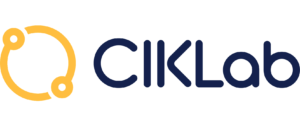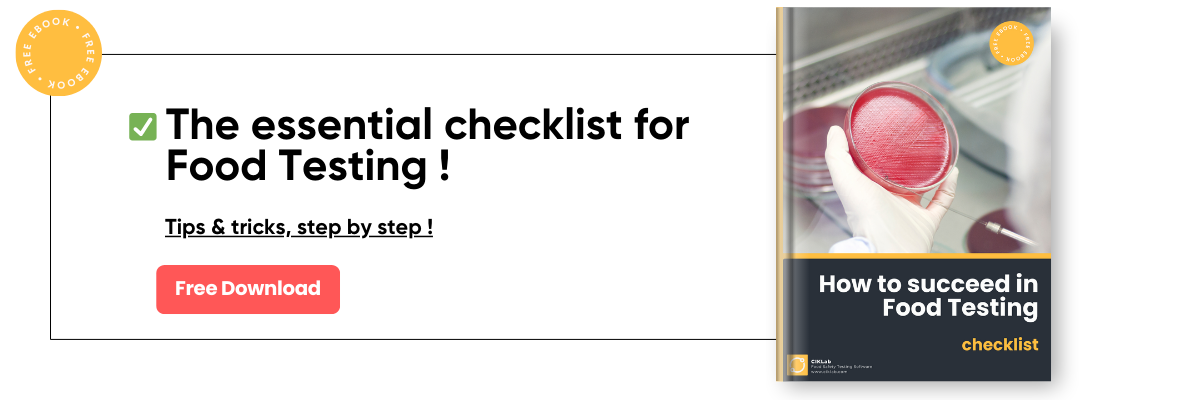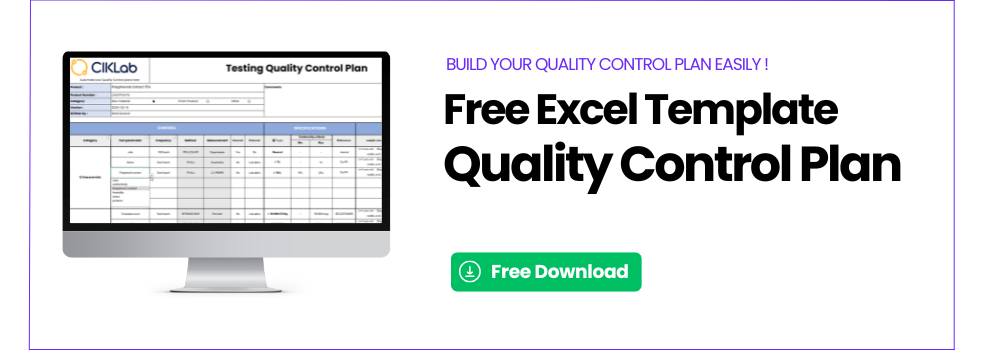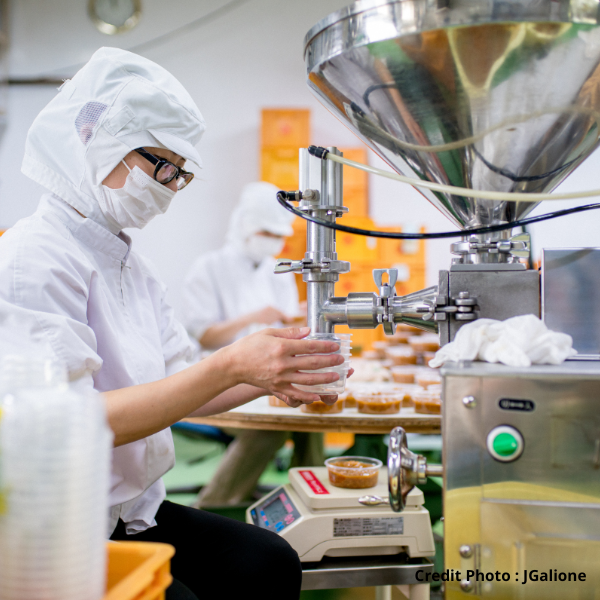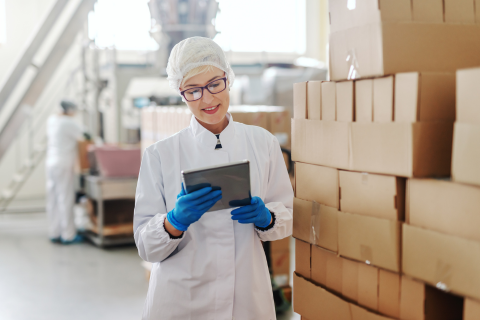CIKLab is an online solution allowing you to organise your control plans and easily track your quality...
When we talk about food contaminants, we refer to hazards that may be present in or come into contact with food products and cause adverse effects for consumers in the short, medium, or long term.
Summary:
1) What are the main European food regulations ?
3) What are biological hazards - microbiological contaminations?
5) What is the allergen hazard ?
6) Easily manage all Food Safety Hazards with CIKLab !
What are the main European food regulations ?
The European regulatory framework aimed at improving food safety includes strict rules concerning food hygiene, known as the "hygiene package" or "Food Law."
Regulation (EC) No 178/2002 forms the basis of this framework. It sets out the general principles of food legislation, establishes the European Food Safety Authority (EFSA), and introduces detailed procedures to ensure food safety.
Other regulations complement this framework, such as Regulations (EC) No 852/2004 and No 853/2004, which specify hygiene rules for food products and products of animal origin, respectively, as well as Regulation (EC) No 183/2005 concerning animal feed, and Regulation (EC) No 2073/2005, which sets microbiological criteria for foodstuffs.
Finally, Regulation (EU) No 1169/2011 specifies consumer information requirements for food products, while Regulation (EU) No 915/2023 sets thresholds for various food contaminants to monitor.
A crucial aspect of these regulations is the requirement for food business operators to implement, apply, and maintain procedures based on HACCP principles, in accordance with Article 5 of Regulation (EC) No 852/2004.
This systematic approach allows for the identification, assessment, and control of significant hazards in food production.
What are food hazards?
When talking about food contaminants, we refer to hazards that may be present in or come into contact with food products, potentially causing harmful effects for consumers in the short, medium, or long term, such as illness or injuries.
Sources of contamination in a food product can be numerous and can occur at various stages, such as during harvest, transport, manufacturing, or storage.
According to the European framework regulation No. EC 178/2002, a hazard is defined as:
"A biological, chemical, or physical agent in food or animal feed, or a condition of that food or feed, that may have an adverse effect on health."
Although the regulation explicitly mentions only three categories, the following four categories have reached consensus in HACCP studies, with allergenic hazards now considered a distinct category:
- Biological
- Chemical
- Physical
- Allergenic
All food industries worldwide face hazards. They are and will always be present because they remain inevitable in the food chain. The key is to identify them, assess their severity and occurrence to evaluate the risk, and implement measures to control these risks. This is the foundation of the HACCP method.
What are biological hazards - microbiological contaminations?
Biological contaminations are caused by living organisms. Among biological hazards, microbiological hazards are the most feared in the food industry, as they are most often implicated in Foodborne illness outbreaks (FIOs)
To recap, a FIOs is defined as the occurrence of at least two cases of similar symptoms, generally gastrointestinal, that can be traced to a common food origin.
Paradoxically, and even though zero risk does not exist, the microbiological risk remains a real challenge for the food industry. Given the technical, scientific, and regulatory developments of recent years, FIOs is now considered unacceptable !
Generally, this category includes microbiological and parasitic hazards:
Bacteria:
- Vibrio parahaemolyticus in shellfish
- Clostridium botulinum in canned goods
- Salmonella spp. in poultry and eggs
- Campylobacter spp. in poultry
- Listeria monocytogenes in deli meats, cheeses
Molds (mycotoxins)
Yeasts
Viruses:
- Hepatitis A and E
- Norovirus
Parasites:
- Echinococcosis – fox tapeworm
- Entamoeba histolytica – amoebic dysentery
- Cryptosporidium parvum – cryptosporidiosis
- Trichinella – trichinellosis
- Taenia solium – pork tapeworm
- Toxoplasma gondii – toxoplasmosis
Microbial toxins:
- Clostridium botulinum, Clostridium perfringens
- Shigatoxins (STX1 and STX2)
- Staphylococcal enterotoxins: SEG, SEI, SER, SES, SET
- Botulinum toxin
- Marine toxins
- ATNC (prion)
During hazard assessment, biological risk is the most common and can be found at all stages, with numerous sources of contamination: raw materials, manufacturing environment, human handling, pests, and water.
The risk of these hazards varies depending on the type of material processed (plant products, meat, eggs, shellfish), the type of process used (sterilization, ultra-fresh), and the format of the products sold (canned goods, fresh salads, etc.).
Most foodborne intoxications of biological origin are caused by bacteria, notably:
- Salmonella (Salmonella Enteritidis, Salmonella Typhimurium)
- Toxin producers: Staphylococcus aureus, Clostridium perfringens, and Bacillus cereus
(Source: DGAL-2024)
The term "microbial or microbiological hazard" is often used incorrectly for this category, unfortunately restricting the scope of biological agents that can cause harmful effects. For example, prions or protein enterotoxins from Staphylococcus aureus should also be considered.
What are chemical hazards?
Chemical contaminants are undesirable substances that may be present in food products and potentially have toxic or harmful effects on human or animal health. Unlike physical, allergenic, and especially biological hazards, chemical contaminations are often more insidious, sometimes unregulated, and can cause long-term issues (cancers, endocrine problems, neurological issues, etc.).
The sources of chemical contaminations are generally classified into two categories:
Natural origin: Contaminants are naturally present in the animal kingdom (e.g., toxins), plant kingdom (alkaloids), or mineral kingdom (e.g., certain trace elements).Anthropogenic origin (human): These contaminants result from human activities, such as industrial pollution, agricultural waste, vehicle emissions, and other sources of environmental pollution.
It's crucial to conduct a rigorous risk assessment that considers the origin of raw materials, their methods of cultivation, treatment, processing, and storage. Raw materials can accumulate various contaminants at different stages of their production and/or processing.
It's also central to evaluate the impact of manufacturing processes on the final products, as they can result in the formation of new chemical compounds, sometimes very toxic (e.g., acrylamide, PAHs).
There are many chemical contaminants to consider in hazard assessments. For the HACCP team, it’s important to work on different "levels": from raw materials to finished products, covering all stages of transformation.
- List exhaustively all possible types of chemical contaminants.
- Define those that are "endogenous" and naturally present in the raw material, for example (e.g., cyanogenic glycosides), and those that may be exogenous.
- Based on the product's origin, cultivation conditions, harvest, processing, and history (RASFF, alerts, recalls), select the most "eligible" and relevant contaminants: pesticides, chlorates, ionizing treatments, thermal treatments (PAHs).
- Also include voluntary adulteration (e.g., melamine), forbidden colorants (saffron), and lead chromate (cinnamon).
- Then define those whose measurement and control are relevant and essential.
- Integrate thresholds and acceptability criteria (if regulatory standards exist); otherwise, they should be defined based on all available data.
- Implement regular controls through surveillance plans.
- Maintain or reduce the presence of identified hazards below predefined criteria.
Here are some major categories of chemical substances:
- Chemical contaminants of natural origin and botanical impurities
- Environmental chemical contaminants
- Processing contaminants (Neoformed)
- Chemical contaminants from Materials in Contact with Food (MCDA)
- Additives, preservatives
- Drug residues
- Radionuclides
- Etc.
What are physical hazards?
Physical contaminants in food, also known as "foreign bodies," are objects or substances that can cause injury or damage to consumers. These physical hazards are mostly "exogenous" such as insects, jewelry, metal pieces, etc., but they can also be naturally present on raw materials (e.g., sand on vegetables, fruit pits, leaves/stems).
These hazards are not always visible to the naked eye and their presence in food can be accidental, but also intentional (Food defense). Regardless, they consistently present a very serious and immediate risk to health.
What are the types of physical contaminants?
Metals: Metal fragments can end up in food due to the deterioration of processing equipment or packaging. Common examples include metal wires from cleaning brushes, staples from ingredient bags, or fragments detached from machinery.
Glass: Glass can contaminate food if utensils, containers, or light bulbs break during production or storage phases. Even small shards are potentially dangerous.
Plastics and rubbers: These contaminants may come from worn parts of processing equipment, such as seals or protective coatings that deteriorate over time.
Stones and sand: These are typically found in foods that have not been adequately cleaned after harvesting, especially vegetables and grains that may have been in direct contact with the soil.
Bones and shells: Although often considered natural, bone fragments in processed meat or shells in egg-based or seafood products constitute a physical hazard.
Wood pieces: These can end up in food due to poor handling of pallets and crates used in the transportation and storage of raw materials.
These types of hazards are known in the industry, and their involvement in product withdrawals/recalls remains rare. Regular audits, good manufacturing practices, prerequisite programs, CCPs, and PrPo allow these risks to be brought towards "zero."
- Facility maintenance,
- Regular audits,
- Staff training,
- Dedicated equipment,
- Implementation of metal detectors,
- Etc.

What is the allergen hazard ?
Food allergens are substances (often proteins) that, while harmless to the majority of individuals, can cause sometimes severe allergic reactions in sensitive people. Over time, managing allergens has become a major and critical issue in food safety, with reactions ranging from mild irritation to potentially fatal anaphylactic shock.
We distinguish between declared allergens, which are part of the food product, e.g., casein in dairy products, and incidental allergens, whose presence is unintentional but can result from cross-contamination on manufacturing lines, for example. Manufacturers are obliged to assess the risk of contamination and reduce it as much as possible.
What are the 14 allergens that must be declared ?
- Cereals containing gluten (wheat, spelt, Khorasan wheat, rye, barley, oats, and their hybrid strains), except:
- Wheat-based glucose syrups, including dextrose.
- Wheat-based maltodextrins.
- Barley-based glucose syrups.
- Cereals used for the production of alcoholic distillates, including agricultural ethyl alcohol.
- Crustaceans and products based on crustaceans.
- Eggs and products based on eggs.
- Fish and products based on fish, except:
- Fish gelatin used as a carrier for vitamin or carotenoid preparations.
- Fish gelatin or isinglass used as a clarifying agent in beer and wine.
- Peanuts and products based on peanuts.
- Soybeans and products based on soybeans, except:
- Fully refined soy oil and fat.
- Natural mixed tocopherols (E306), natural D-alpha tocopherol, natural D-alpha tocopheryl acetate, and natural D-alpha tocopheryl succinate derived from soy.
- Phytosterols and phytosterol esters derived from soybean oils.
- Vegetable stanol ester produced from sterols derived from soybean oils.
- Milk and products based on milk (including lactose), except:
- Whey used for the production of alcoholic distillates, including agricultural ethyl alcohol.
- Lactitol.
- Nuts (almonds, hazelnuts, walnuts, cashews, pecans, Brazil nuts, pistachios, macadamia nuts, or Queensland nuts), except for nuts used for the production of alcoholic distillates, including agricultural ethyl alcohol.
- Celery and products based on celery.
- Mustard and products based on mustard.
- Sesame seeds and products based on sesame seeds.
- Sulfur dioxide and sulfites at concentrations greater than 10 mg/kg or 10 mg/liter expressed as total SO2, for products ready to consume or reconstituted according to the manufacturer's instructions.
- Lupin and products based on lupin.
- Molluscs and products based on molluscs.
Only sulfites (10 ppm) and gluten (20 ppm) have a threshold.
Managing allergen hazards involves a complete listing of all products handled by the company, segmentation in space and time of the storage and/or handling of products containing allergens, strict adherence to cleaning and manufacturing procedures, mandatory labeling, and control testing !
Easily manage all Food Safety Hazards with CIKLab !
CIKLab is an application dedicated to food monitoring plans.
This app assists food industry companies in rigorously monitoring and controlling critical limits for each identified hazard.
CIKLab easily manages the monitoring process and allows for the automation of all data related to analyses, methods used, both internal and external laboratories, and critical specifications or limits.
Most importantly, the application is specifically configured to initiate automatic control reminders for each product or process monitoring plan !
©2024 CIKLab.com All rights reserved.
